Heian-jingu Shrine is a Shinto shrine located in Sakyo-ku Ward, Kyoto City, Kyoto Prefecture.
This Shrine was built to commemorate 1,100th anniversary of the transfer of national capital to “Heian-kyo(Ancient Kyoto)” in 1895.
Therefore, this Shinto shrine are relatively new Shinto shrines.
The highlight of this Shinto shrine is “the building which reproduced the times of Heian-kyo” and “the Japanese garden of Heian-jingu Shrine“.
This area is maintained as the Okazaki Park to be a cultural zone.
And then, this area is the location of Kyoto’s cultural, tourism and industrial institutions including the Kyoto Municipal Museum of Art, National Museum of Modern Art, Kyoto, and Kyoto Prefectural Library.
Contents:
- About Heian-jingu Shrine
- The building which reproduced the times of Heian-kyo
- The Japanese garden of Heian-jingu Shrine
- Goshuin(The stamp of shrine or temple) of Heian-jingu Shrine
- How to get to Heian-jingu Shrine
1.About Heian-jingu Shrine
The Heian Shrine (平安神宮 Heian-jingū) is a Shinto shrine located in Sakyō-ku, Kyoto, Japan. The Shrine is ranked as a Beppyou Jinja (the top rank for shrines) by the Association of Shinto Shrines. It is listed as an important cultural property of Japan.
引用(citation):https://en.wikipedia.org/wiki/Heian_Shrine
Open:6:00~18:00(Shrine office:7:30~,The Japanese Garden:8:30~)
Admission Fee:Free(The Japanese Garden:600 yen(high school student or older),300 yen(Junior high school student or younger))
Adress:Okazaki Nishitennocho, Sakyo-ku Kyoto-shi, Kyoto, 606-8341, Japan
Phone Number:+81-75-761-0221
Heian-jingu Shrine was built to commemorate 1,100th anniversary of the transfer of national capital to “Heian-kyo(Ancient Kyoto)” in 1895.

This is precincts guide map of this Shinto shrine.
The shrine precinct covers an area of approximately 66,200 square meters, including the traditional Japanese garden known as ‘Heian-jingu Shinen,’ the approximately 33,100 square meters.

This is the Otorii (a large gateway to a Shinto shrine) of the entrance of Heian-jingu Shrine.
This Otorii was designated as a registered tangible cultural property of Japan.
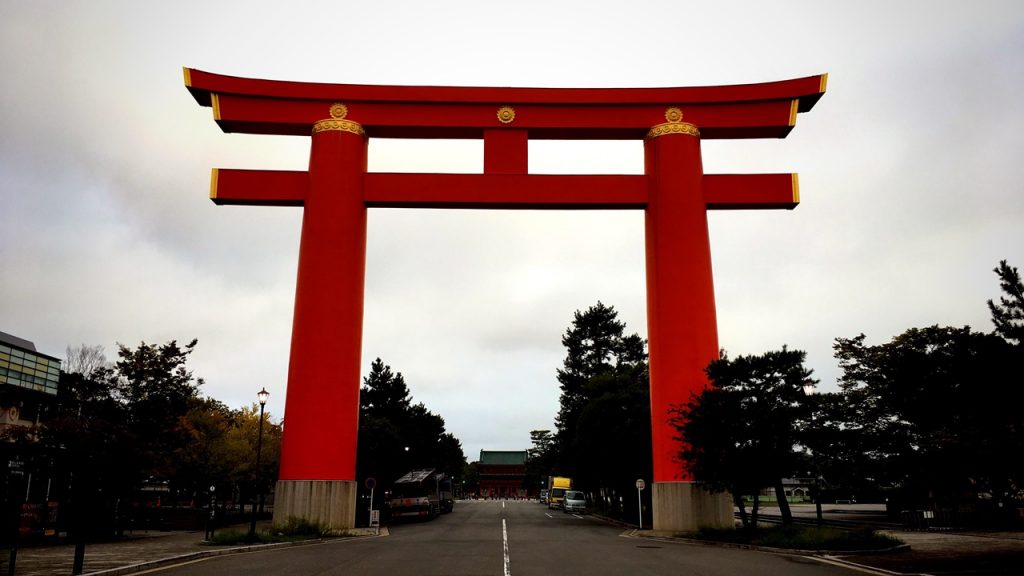
This Otorii, height is 18m and width is 24m.
This is very big!!(*´・ェ・`*)

The Heian-jingu Shrine area is maintained as the Okazaki Park to be a cultural zone.
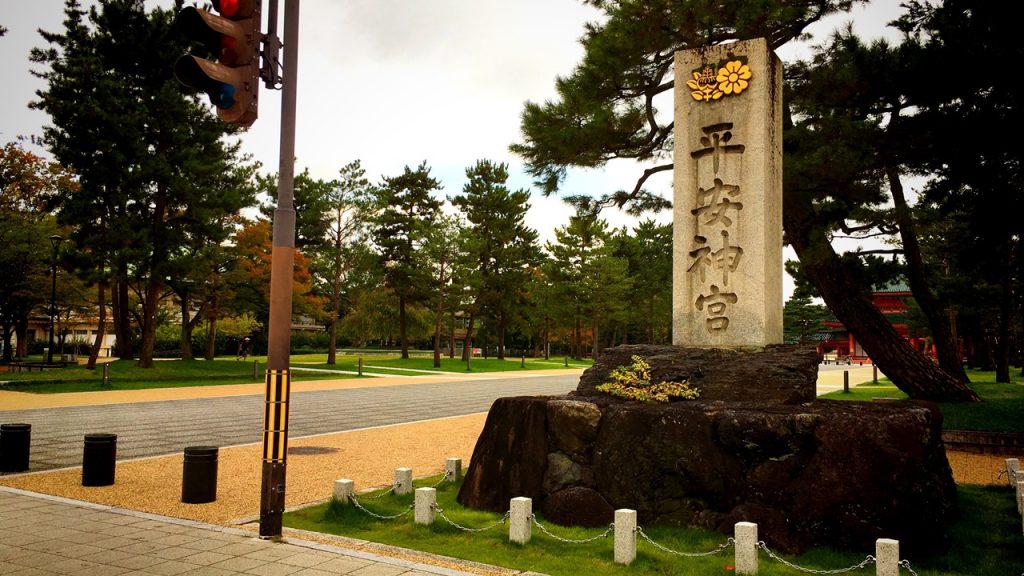
There is an approach to a shrine called “Jingumichi road” in Okazaki Park.

This is the Kyoto Municipal Museum of Art which is located in a cultural zone.

This is the National Museum of Modern Art (Kyoto) which is located in a cultural zone.
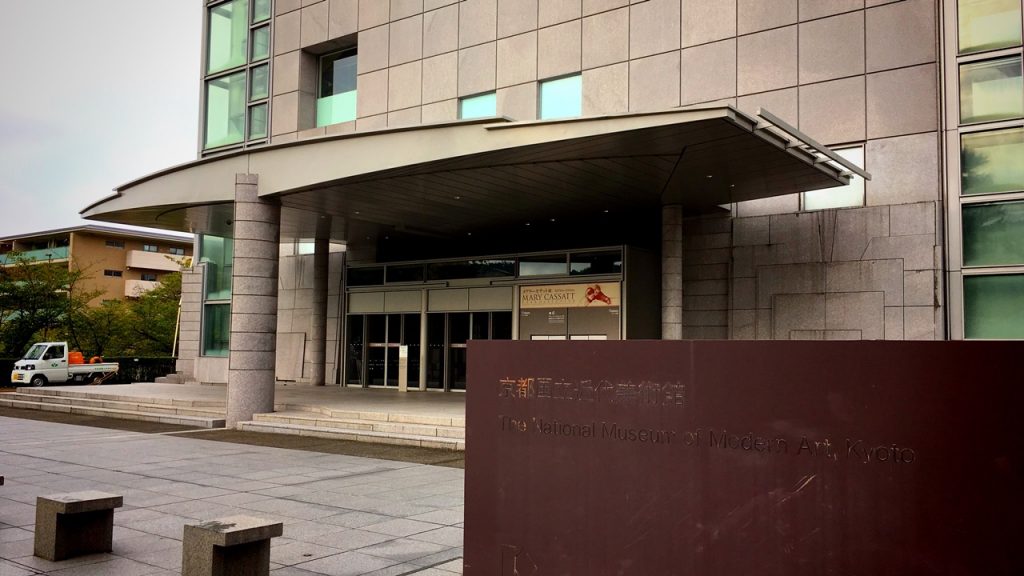
This is the Kyoto Prefectural Library which is located in a cultural zone.

2.The building which reproduced the times of Heian-kyo
The Heian-jingu Shrine was built to imitate the Chodoin of the Heiangu Palace, restoration was done on the facilities like; Daigoku-den, Oten-mon Gate and Daidairi Chodoin (a large main hall of Daidairi) in small scale than original ones inside the Palace.
This gate was designated as a important cultural property of the country.

This gate is a 5/8-sized imitation of the one in Heijo-kyo Capital.

The monument of national foundation of Japan was built in the west of this gate.
The founding-year of a country of Japan is said to be B. C. 660 when the Emperor Jinmu who is the first Emperor succeeded to the throne.

Then let’s enter the precincts.

The Chozuya is to the east and west of the precincts.
This is the Chozuya at the west side.
The stone statue of the god of the western heaven called “Byakko(White Tiger)” is enshrined in this Chozuya.

This is the Chozuya at the east side.
The stone statue of the god of the western heaven called “Seiryu(Blue Dragon)” is enshrined in this Chozuya.

A building in the center of the precincts is the Daigoku-den which is the main palace of this shrine.
This building was designated as a important cultural property of the country.

The Daigoku-den also is a 5/8-sized imitation of the one in Heijo-kyo Capital.

Between “precincts of the shrine” and “the Daigoku-den”, there is a step(border) which is called “Ryubidan Steps“.

Only a noble was able to go this border in old days.

This is the Ukon-no-Tachibana (the Mandarin Orange tree of the right) which is planted on the right side of the Daigoku-den.

This is the Sakon-no-Sakura (the Cherry tree on the left) which is planted on the left side of the Daigoku-den.

The tree which is in front of this building is called “Musubi-no-ki tree“.
The Omikuji(fortune slip) were tied to this tree to tie a link (‘en wo musubu’) with the Gods.

Over the Ryubidan Steps, at the left and right side of the Daigokuden two small Rokaku (pagoda style buildings) called ‘Byakkoro’ (literally White Tiger Tower) and ‘Soryuro’ (literally Blue Dragon Tower) are situated opposite each other.
This is the ‘Byakkoro’ (literally White Tiger Tower) at the west side.
This tower was designated as a important cultural property of the country.

This tower is also an entrance of the Japanese garden.

This is the ‘Soryuro’ (literally Blue Dragon Tower) at the east side.
This tower also was designated as a important cultural property of the country.

This is the Gakuden at the west side of the precincts of this Shinto shrine.
This building was designated as a registered tangible cultural property of Japan.

This is a building where votive tablets and pictures are kept.

This is the Kagura Hall (Kaguraden) at the east side of the precincts of this Shinto shrine.
This building also was designated as a registered tangible cultural property of Japan.

This building is a place to dedicate the performance of the noh dance.
In addition, this building is also used now as a marriage ceremonial hall.

3.The Japanese garden of Heian-jingu Shrine
The garden of Heian-jingu Shrine is a modern Japanese garden of the chisen kaiyu style (a style of Japanese garden with a path around a central pond).
And, this garden is designated as a national scenic beauty.
It consists of Minami (south) Shin-en Garden, Nishi (west) Shin-en Garden, Naka (middle) Shin-en Garden, and Higashi (east) Shin-en Garden that enclose the three sides behind Heian-jingu Shrine Daigokuden.
An entrance of the gardens is the ‘Byakkoro’ (literally White Tiger Tower)which is in the west side of the precincts.

An admission fee is 600 yen(high school student or older).

- Minami (south) Shin-en Garden
- Nishi (west) Shin-en Garden
- Naka (middle) Shin-en Garden
- Higashi (east) Shin-en Garden
●Minami (south) Shin-en Garden
“Minami (south) Shin-en Garden” is also called “Heian-no-sono garden“.
Approximately 180 kinds of flowers appearing in the Japanese old book (The Tale of the Bamboo-Cutter, The Tale of Genji…etc) are planted in this garden.

This is the first Japanese “ding-ding-train”.
When it sets off the bell rings, “ding-ding”. Thus ‘ding-ding-train’.

●Nishi (west) Shin-en Garden
There is a pond called “Byakko-ike Pond” in the center of “Nishi (west) Shin-en Garden”.
Approximately 200 kinds of blue flags are planted in this pond. (The time of bloom is May and June.)
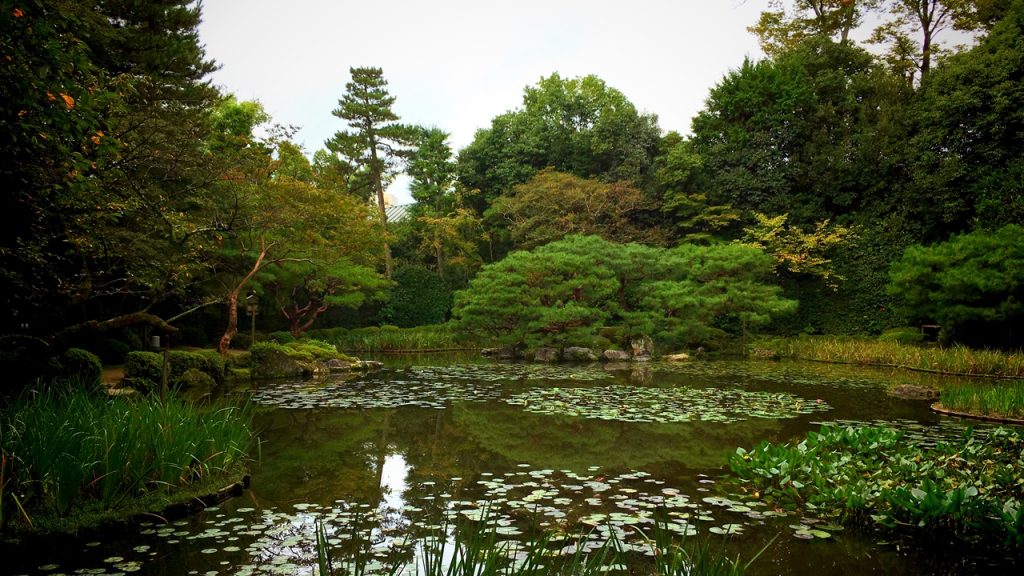
Ducks were eating the bait. (○´艸`)
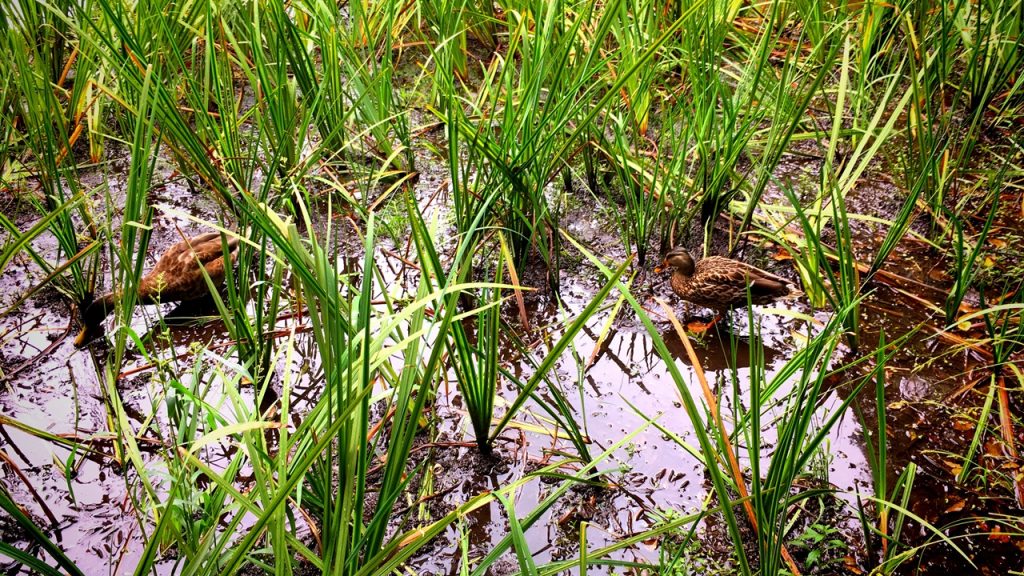
This is an entrance of a tea ceremony room named “Choshin-tei“.
Unfortunately this tea-ceremony room usually cannot enter.
(At the day of a tea ceremony held once a month, we can enter this room.)

●Naka (middle) Shin-en Garden
There is a pond called “Soryu-ike Pond” in the center of “Naka (middle) Shin-en Garden”.

There are the island which is called “Sango-jima island” on the east side of this pond.

There is the bridge made of stepping stones called “Garyukyo Bridge” in this island.
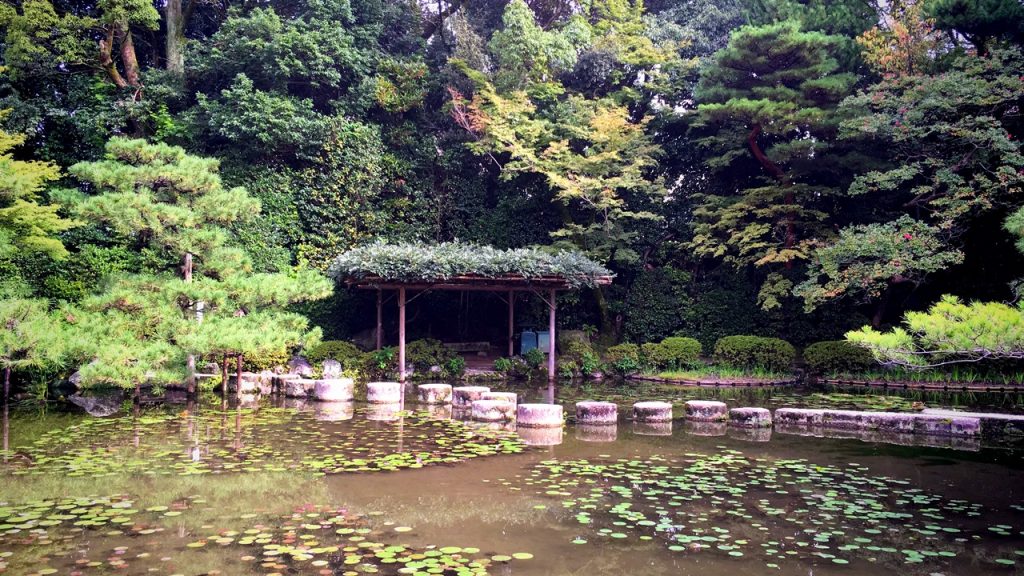
We can cross this bridge on foot.
However, please be careful not to fall into the pond!! (*´・ェ・`*)
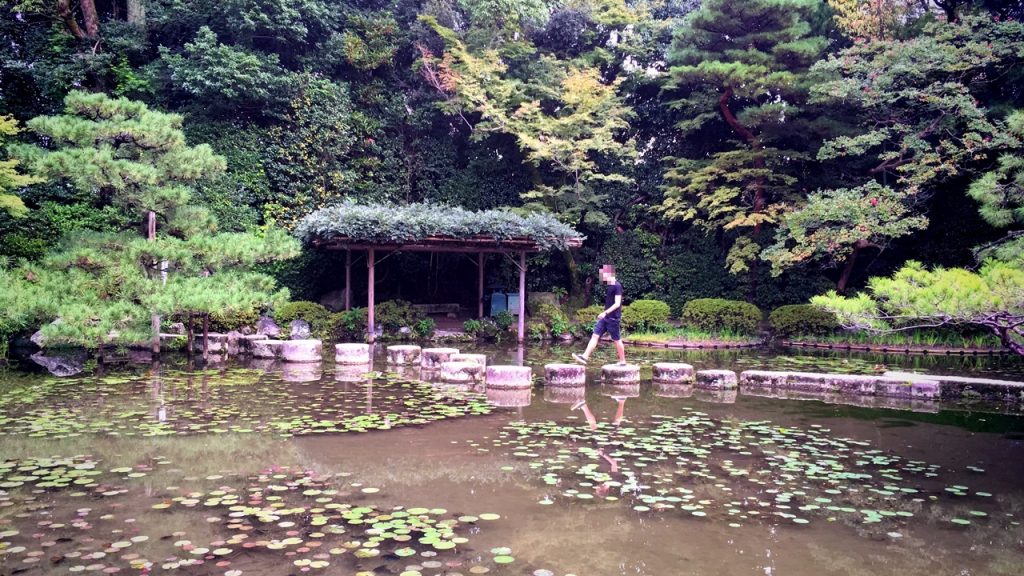
Around this pond, a rare “Kakitsubata (Iris)” which is named “Orizuru(FOLDED-PAPER CRANE)” is planted.
(The time of bloom is May.)

This is the Jinushi-sha Shrine which was built in the edge of this pond.
“Otokonushi-no-kami” is enshrined in this Shinto shrine, and there is divine favor of a “charm against accidents“.

●Higashi (east) Shin-en Garden
There is a pond called “Seiho-ike Pond” in the center of “Higashi (east) Shin-en Garden“.

This is the Shobi-kan(guest house) which was built in the edge of this pond.

This building was relocated from the Kyoto Imperial Palace, and was rebuilt in 1913.

This is the Taihei-kaku.
Because this building looks like a bridge(Japanese word “Hashi”) built over the pond, it is also called “Hashidono“.

This building also was relocated from the Kyoto Imperial Palace, and was rebuilt in 1913.

This building looks like a bridge built over the pond.

The Shobi-kan(guest house) is seen on the right side of this building.

And the Heian-jingu Shrine Hall(wedding reception hall) is seen on the right side of this building.

This is the Shinto priest-purification shelter(Saikan).
This building was designated as a registered tangible cultural property of Japan.
This building is a place to cleanse mind and body before a Shinto priest performs Shinto ritual.
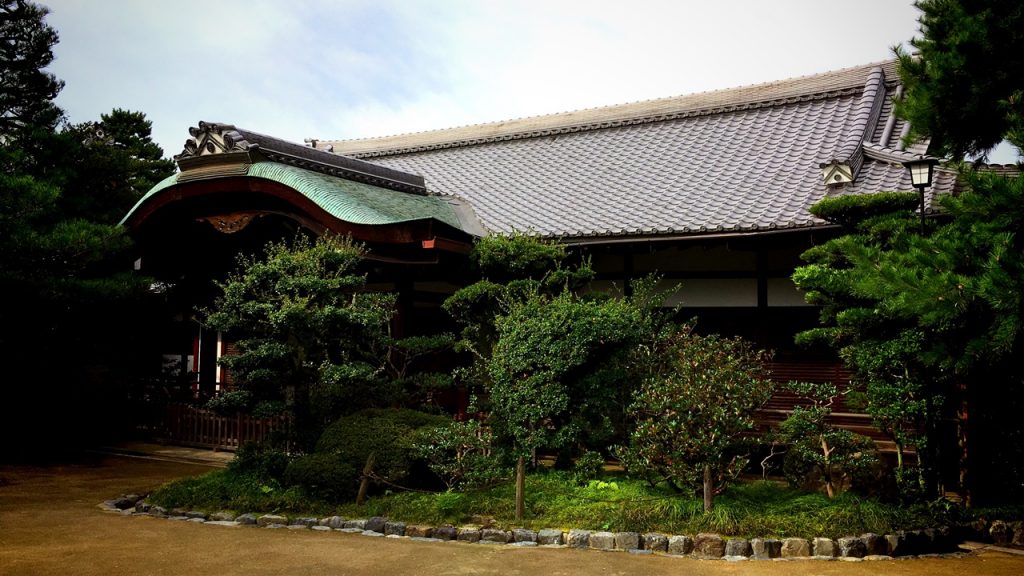
The stone pillar is made of stones from the legs of Sanjo-ohashi Bridge and Gojo-ohashi Bridge, which were built by Hideyoshi TOYOTOMI during the Tenshu period (1573-1592).
A part of this stone pillar is used as materials of “Garyukyo Bridge“.

This is an exit of this garden.

4.Goshuin(The stamp of shrine or temple) of Heian-jingu Shrine
The word which can read as “平安神宮(Heian-jingu)” is written to Goshuin with a sumi.
“平安神宮(Heian-jingu)” is the name of this Shrine.

5.How to get to Heian-jingu Shrine
The nearest station of Heian-jingu Shrine is “Kyoto City Subway Higashiyama Station”.
It is about 10-minutes walk from the station.
■Route Example (From Osaka Station to Higashiyama Station)

■Route Example (From Namba Station to Higashiyama Station)

■Route Example (From Kyoto Station to Higashiyama Station)

■Higashiyama Station→Heian-jingu Shrine

How did you like it?
“Heiankyo” which was the capital of ancient times of Japan.
This Shinto shrine can taste this atmosphere.
Everyone please try and go. XD
Have a nice trip! XD
<Let’s search the sightseeing information of Kansai in Japan on ‘Japan’s Travel Manual‘!!>
<This site introduces the easiest way to get Japanese (Kansai) sightseeing spots to you.>










